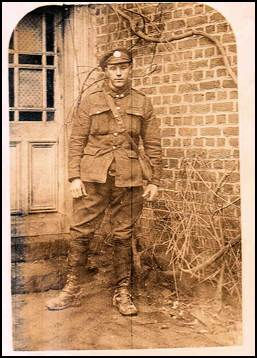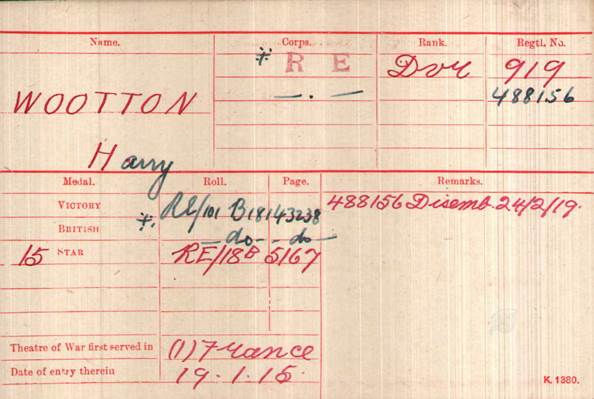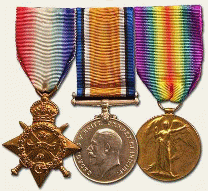
488156
Driver
HARRY WOOTTON
Royal Engineers
By
Lieutenant Colonel Edward De
Santis, MSCE, P.E., MinstRE
(March 2023)

Figure 1. 488156 Driver Harry
Wootton, R.E.
(Image from the author’s collection)
NOTE: The postcard photograph above is marked CARTE POSTALE on the reverse side indicating that it was taken in France.
1. INTRODUCTION
The handwritten note on the back side of the postcard was the first clue in determining and details of Driver Wootton’s service in the Great War of 1914-1918. Someone, perhaps Wootton himself, wrote the following in pencil on the back of the card:
Dvr H Wootton
466 Coy RE
46 Div
With this information it was possible to check the Ancestry.com web site for his Medal Index Card (MIC). The cards for three Harry Woottons were found. The first card was for Driver Harry Wootton, Regimental Numbers 919 and 488156, who had gone to France on 19 January 1915 and had been awarded the 1914-15 Star, British War Medal and Victory Medal for his service. The second card was for Sapper Harry Wootton, Regimental Numbers 258082 and WR/42944, whose card did not show a date of deployment to a theater of the war; hence, he only received the British War Medal and Victory Medal for his service. The third card was for Private Harry Wootton,[1] with five different Regimental Numbers, as he had served in the Manchester Regiment, the Army Service Corps, the Training Reserve, the Labour Corps, and the Royal Engineers. The second and third Medal Index Cards were simple to eliminate as neither of the men had been Drivers and apparently neither of them had served in France. Now all that was required was to verify that the first MIC was that of the man in the photograph.
The first step in this verification was to study the units that Driver Wootton had written on the back of his postcard. The 466th Field Company, R.E. did indeed serve in the British 46th Division during the war. The company originally was designated the 1/2nd North Midland Field Company when it was part of the Territorial Force; hence, the Regimental Number 919 on the MIC. When the company was called up for service during the war as part of the regular forces, Wootton’s Regimental Number was changed to 488156. To verify that this regimental number was one issued to men in the 466th Field Company, a check was made of the casualties suffered by the company to determine the numbers of the men who died while serving with the company.[2] The casualty list for the company contained 1 Officer and 17 Other Ranks names, 9 of which (52.9%) were in the series 488XXX, making it almost certain that the MIC shown below was that of Driver Harry Wootton and that the postcard photograph shown in Figure 1 above is Harry Wootton.
The remainder of this study will be devoted to the service of Harry Wootton by way of discussing the service of his company during the war. Unfortunately no personal information regarding him could be found on Ancestry.com in the way of a family tree.

Figure
2. The Medal Index Card of 488156 Driver Harry Wootton,
R.E.
(Image courtesy of Ancestry.com)
2. SERVICE IN THE GREAT WAR
46th (North Midland) Division
To start Harry Wootton’s story it would be of value to review the service of the 46th Division during the war.[3] The North Midland Division was a formation of the Territorial Force (TF). It was formed as a result of the reforms of the army carried out in 1908 under the Secretary of State for War, Richard Burdon Haldane and was one of 14 Divisions of the peacetime TF. All units were mobilised for full time war service on 5 August 1914. The units of the 46th Division concentrated in the Luton area by mid-August 1914.
King George V inspected the Division on 19 February. Advance parties landed at Boulogne on 23 February and eight days later the units began to arrive. Concentration was completed by 8 March. The North Midland was thus the first TF Division to arrive complete in a theatre of war. The first months were spent in the Ypres salient.
On 12 May 1915 the Division was retitled as the 46th (North Midland) Division and the brigades were also retitled. The Division then took part in the following engagements:
· The German liquid fire attack at Hooge (30-31 July 1915)
· The attack at the Hohenzollern Redoubt (13 October 1915)
On 23 December 1915 the Division was ordered to proceed to Egypt, leaving the Divisional Ammunition Column (for the 55th Division), the Divisional Train (with the 56th Division) and the Mobile Veterinary Section. Most units reached Egypt via Marseilles by 13 January 1916.
After just a few days in Egypt, the move of the Division was countermanded and the units were returned to France, whereupon the Divisional Ammunition Column, the Divisional Train and the Mobile Veterinary Section rejoined the Division. The Division remained in France and Flanders for the rest of the war, taking part in the diversionary attack at Gommecourt on 1 July 1916. In 1917 the Division took part in the following engagements:
· Operations on the Ancre (March)
· Occupation of the Gommecourt defences (4 March)
· The attack on Rettemoy Graben (12 March)
· The German retreat to the Hindenburg Line
· The attack on Lievin (1 July)
· The Battle of Hill 70 (15-25 August)
During the last year of the war the Division remained heavily engaged and took part in the following battles:
· The Battle of the St. Quentin canal, including the passage of the canal at Bellenglise*
· The Battle of the Beaurevoir Line*
· The Battle of Cambrai*
· The Battle of the Selle**
· The Battle of Sambre**
NOTES:
(*) These battles are phases of the Battles of the Hindenburg Line.
(**) These battles are phases of the Final Advance in Picardy.
The forward units of the Division were at Sains-du-Nord on 11 November 1918. Not selected to join the Army of Occupation, the Division moved back to Landrecies on 14-15 November. Units moved to the Le Cateau area in early January 1919 and demobilization began. By June it was down to cadre level. The Division reformed as part of the Territorial Army in April 1920.
The 466th Field Company
Like all field companies, the 466th Field Company of the Royal Engineers would have been composed of 217 men during the Great War. The personnel of the company consisted of the following:
· A Major in command of the company.
· A Captain as second in command.
· 3 Lieutenants (or 2nd Lieutenants), one each commanding a Section.
· 9 Senion Non-Commissioned Officers (Company Sergeant Major, Company Quartermaster Sergeant, a Farrier Sergeant and 6 Section Sergeant.
· 14 Junior Non-Commissioned Officers (7 Corporals and 7 2nd Corporals or Lance Corporals).
· 186 Other Ranks (1 Shoeing Smith, 1 Trumpeter, 1 Bugler, 138 Sappers, 37 Drivers and 8 Batmen).
Driver Harry Wootton had been serving in the Territorial Force when the Great War started. He would have already enlisted in the TF and probably had received a good amount of training with the 1/2nd North Midland Field Company during its annual exercises, so for practical purposes he was quite ready for active service.
The
company mobilized at Derby in August 1914 and it spent the period
from September 1914 to January 1915 at Luton, Bedfordshire and
Bishop’s Stortford, Hertfordshire. This period was spent
outfitting the company, training and preparing it for deployment with
the division. The company embarked for France in February 1915;
however, according to Wootton’s MIC he arrived in France on 19
January 1915. It would appear that while the advance parties of
many of the division’s units landed in France on 23 February, the
466th Field Company sent men ahead as early as
mid-January.
The 466th Field Company assembled in a reserve
position at Neuve Chapelle from 12 to 13 March 1915 and then spent
April through September at Ploegsteert, Kemmel, Neuve Eglise and Hill
60. The company was at Bethune on 13 October during the attack
at the Hohenzollern Redoubt and spent the period from November 1915
to January 1916 at The Quarries and Fosse 8, moving to Vimy Ridge in
February. On 1 July 1916, the day of the start of the large
British offensive on the Somme, Wootton and his company were at
Gommecourt, taking part in the 46th Division’s
diversionary.
During the period from March to June 1917 the company made many moves in support of the division operations listed above. The company moved to Rettemoy Graben, Lens, Cite St. Edward, Cite St. Theodore, Cite Jeanne d’Arc, Cite de Riaumont, Bois de Lievin, Bois de Riaumont and Hill 65. The company took part in the Battle of Hill 70 from 15 to 25 August 1917.
The early months of 1918 were relatively quiet for the 466th
Field Company. When the Battle of St. Quentin Canal (29
September to 2 October) began the company was at Requeval Bridge.
It then took part in the Battle of Beaurevoir from 3 to 5 October and
the actions at Cambrai from 8 to 9 October, the Selle 17 to 25
October, and the Sambre 4 November. On 8 November 1918 the
company was located at the Petite Helpe River.
Wootton’s Medal Index Card shows that he was “disembodied” on 24 February 1919. It appears that on this date he and other members of the company were returned to their Territorial Force status and were no longer in the Regular Army establishment.
Casualties of the 466th Field Company
Although the unit was not heavily engaged during the war it did suffer 18 losses from various causes as shown in the table below, listed alphabetically by date of death.[4]
Name |
|
Rank |
|
Date of Death |
Phipps, G (1) |
1294 |
Sapper |
Died |
16 Apr 1915 |
Taylor, Isaac |
488639 |
L/Corporal |
KIA |
13 Oct 1915(2) |
Heald, F.J. (1) |
197 |
L/Corporal |
KIA |
21 Oct 1916 |
Clarke, Harold Arthur |
488214 |
Sapper |
KIA |
26 Apr 1917 |
Thompson, Patrick Stapler |
|
Lieutenant |
KIA |
27 Apr 1917 |
Pickard, George |
488062 |
Driver |
KIA |
8 May 1917 |
Price, Herbert |
488123 |
Driver |
DOW |
8 May 1917 |
Forman, Arthur |
183867 |
Sapper |
DOW |
3 Jul 1917 |
Marklew, William H. |
488048 |
Driver |
Died |
24 Aug 1917 (3) |
Darlington, William |
145640 |
Sapper |
DOW |
24 Nov 1917 |
Stringer, J. |
488101 |
Sapper |
KIA |
23 Mar 1918 |
Goodehild, Ernest Harold |
488179 |
Sapper |
DOW |
22 Apr 1918 |
Picken, C. |
412762 |
Sapper |
KIA |
27 May 1918 |
Sawford, John Thomas |
488143 |
Sapper |
DOW |
18 Jun 1918 |
Robinson, A. |
426539 |
Sapper |
KIA |
20 Jun 1918 |
Houghton, Frederick Kendrick |
488223 |
Sapper |
KIA |
6 Jul 1918 |
Taylor, William |
471585 |
Sapper |
DOW |
29 Oct 1918 (4) |
Boulton, Charles |
488673 |
CQMS |
Died |
11 Nov 1918 (5) |
Legend: KIA – Killed in Action; DOW – Died of Wounds; Died – of disease or accidentally killed.
The following is a statistical analysis of these deaths by various categories:
1. Total Company Casualties from all Causes: 18
2. Deaths by Rank
Lieutenants: 1
Company QM Sgt.: 1
Lance Corporals: 2
Sappers: 11 (61.1%)
Drivers: 3 (16.7%)
3. Death by Year
1915: 2 ( 11.1%)
1916: 1 (5.5%)
1917: 7 (38.9%)
1918: 8 (44.5%)
TABLE NOTES:
(1) Sapper Phipps and Lance Corporal Heald still had their old Territorial Force Regimental Numbers when they died in France.
(2) Lance Corporal Isaac Taylor was killed on 13 October 1915 during the attack at the Hohenzollern Redoubt.
(3) Driver William Marklew was killed during the Battle of Hill 70 on 24 August 1917. He may have been killed accidentally.
(4) Sapper William Taylor died of wounds, perhaps received during the Battle of the Selle.
(5) Saddest of all, Company Quartermaster Sergeant Charles Boulton, 34 years old, died on the last day of the war. He may have been the first company victim of the Spanish Influenza.
3. MEDALS, AWARDS AND DECORATIONS
For his service during the war Driver Harry Wootton was awarded the 1914-15 Star, British War Medal, and Victory Medal, as shown on his Medal Index Card. Examples of these medals are shown in Figure 3 below.

Figure 3. The 1914-15 Star,
British War Medal, and Victory Medal.
(Image from the
author’s collection)
NOTE: These are not Wootton medals. The image above is presented to show what the medals look like. The whereabouts of Wootton’s medals are unknown to the author.
REFERENCES:
Books
PRIESTLEY, R.E. Breaking the Hindenburg Line: The Story of the 46th (North Midland) Division. T. Fisher Unwin, Ltd., London, 1919.
Computer Database
Soldiers Died in the Great War. A Searchable Digital Database by The Naval and Military Press Ltd, Darlington, East Sussex, 1998.
Internet Web Sites
The Long, Long Trail: 46th (North Midland) Division.
https://www.longlongtrail.co.uk/army/order-of-battle-of-divisions/46th-north-midland-division/
Commonwealth War Graves Commission.
https://www.cwgc.org/find-records/find-war-dead/
Military Documents
Medal Index Card of 488156 Driver Harry Wootton, R.E.
Periodicals
The Royal Engineers Journal. Battle Honours of the Royal Engineers. The Institution of Royal Engineers, Chatham, Kent, 1925-1932.
ENDNOTES:
[1] The rank of Private did not exist in the Royal Engineers. It was used on the MIC as his first rank in the Manchester Regiment and no rank is shown next to his subsequent postings to other units.
[2] Soldiers Died in the Great War.
[3] The Long, Long Trail.
[4] Commonwealth War Graves Commission and Soldiers Died in the Great War.